Background
From the people perspective, there is no end-to-end view of cross-agency user journeys in the government web domain. This is a problem for several reasons:
- people can only find information about services in separate, incomplete chunks with little or no details on how to transition from one agency to another
- staff only see the portion of the journey that their agency handles
- the system has gaps where people get lost when their journey moves from one agency to another.
Our hypothesis in the Lab+ experiment is that if we made a publicly available, comprehensive and machine-readable dataset of human services across the central government, it could be used by multiple agencies plus the private and community sectors to feed into various service delivery intermediaries. If the experiment proves useful, we will look into prototyping and automating it.
Government Services Register and Services Finder
The basic idea is that we’ll combine a number of existing data sets into one 'superset' of government services hosted on Data.govt.nz so it has an easy-to-consume JSON-enabled Application Programming Interfaces (APIs). For a Minimal Viable Product (MVP) test case, we created a one-off snapshot superset combining six existing datasets from public sector agencies. Ideally, the completed superset will be hosted on Data.govt.nz, which is built on the CKAN platform and automatically creates APIs. Right now there are test datasets on Data.govt.nz for experimenting.
The Services Finder is just a demonstrator of how you could surface such a register in a useful way, but we anticipate many use cases could emerge including third-party service providers for government services. Ideally a service finder tool would be hosted on Govt.nz. We anticipate that a front-end Services Finder and a back-end Services Register would provide benefits for New Zealanders, government agencies and other service providers. Based on the Lab+ work, related research and ongoing conversations within the team and people in agencies, the Values Matrix below shows where we think it'll add value to Government and New Zealanders.
| Value | Service Register (data 'superset') | Services Finder |
|---|---|---|
| Value to New Zealanders | Yes | Yes |
| Value to agencies | Yes | Yes |
| Value to AoG web domain | Yes | Yes |
| Effort / scale | Medium | Challenging (see below) |
| Long-term benefits | Yes | Yes |
To implement the Services Register properly we'd need to identify sources of truth where they exist (e.g. funding systems that store information about the Family Services Directory or lists of services in programme areas of agencies). This automation is not particularly hard, but would take a little time.
To implement a fully functional Service Finder would mean drawing on the Services Register and also codifying all the business rules around entitlements and conditions to those services, which is the reason for the 'Challenging' note. Agencies hold this information but this approach would mean that the business rules would need to be defined and collected (or converted) into a consistent format.
Why an All of Government (AoG) Service Register?
An AoG Services Finder would:
- give agencies and New Zealanders an authoritative source of information about services from a single source (the API from the superset)
- be automatically updated to reflect changes in the source datasets including business rules that determine eligibility (e.g. a minimum or maximum age to receive a service)
- reduce content duplication and contradictions
- make it easier for New Zealanders to find what they’re eligible for
- let agencies hand-off New Zealanders to the next part of a user journey seamlessly.
An AoG Services Register dataset hosted on Data.govt.nz:
- could be reused for future DIA life events development and service design
- include metadata to support use by an agency, non-governmental organisation (NGO), or civil society
- turn foundation assets into components: build the ‘sedan’ to give others option to build a ‘Ferrari’
- could be presented on Govt.nz (or any website) for multiple purposes
- could be a data exemplar: machine-readable, rich metadata, API-ready, agencies can update data directly and consume the dataset themselves
- supports open government (NZ is a member of the international Open Government Partnership) and open data principles.
Proposed approach to deliver an AoG Human Services Register
To start with, we have drawn the Family Services Directory together into one machine readable file and published it on the test Data.govt.nz site for experimentation of a reusable services register as a prototype common service (thanks Ministry of Social Development). We are working with some other life event service delivery teams who wish to reuse this register and would also love a central government services register. We have mashed together several 'human services registers' we found just within the Department of Internal Affairs to get an experimental prototype for the purpose of testing. If it meets a need, it could be a candidate reusable component.
Figure 1 shows how such a service could be then kept up to date.
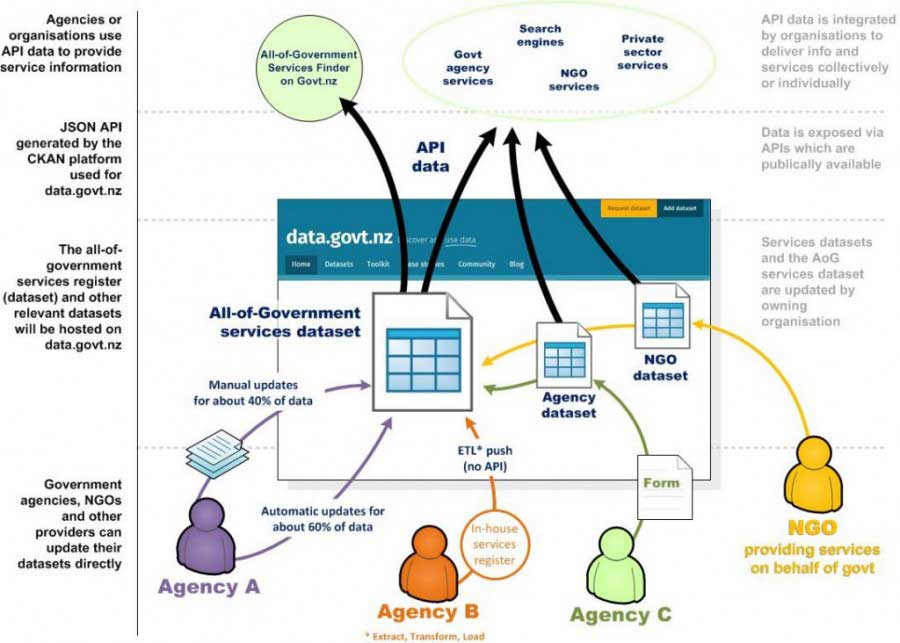
Detailed description of figure 1
This is a draft process diagram of the Services Finder that shows how government agencies, search engines like Google, NGOs like Plunket, and private companies can use datasets to provide up-to-date information about services they provide. The all-of-government services register (or ‘superset’) and other relevant datasets will be hosted on data.govt.nz.
Data.govt.nz is built on the CKAN platform, which creates Application Programming Interfaces or APIs automatically. APIs share information between the datasets and websites. Government agencies, search engines like Google, NGOs like Plunket, and private companies can then use APIs to provide up-to-date information about services they provide.The diagram shows the different ways that datasets – including the superset – can be updated by the agencies that created them. Depending on the organisation, they could update their information in the data set manually, automatically or a mix of both. If the organisation collects data differently than the superset, they could convert it to match. For example, if an agency lists names as “Surname, FirstName” but the superset needed it to be “FirstName Surname” then they would start by converting the information. This process is referred to as Extract, Transform, Load or ETL.While organisations could use the superset for different purposes or specific audiences (like new mums, senior citizens or applying for a benefit), the intent for Govt.nz is to show all government services and let people choose filters that fit their own needs.
Draft mock-ups of the AoG Services Finder
Figure 2 is a mock-up of the Government Services Finder hosted on Govt.nz. The Services Finder allows people to search for services that fit their needs by life event or circumstances.
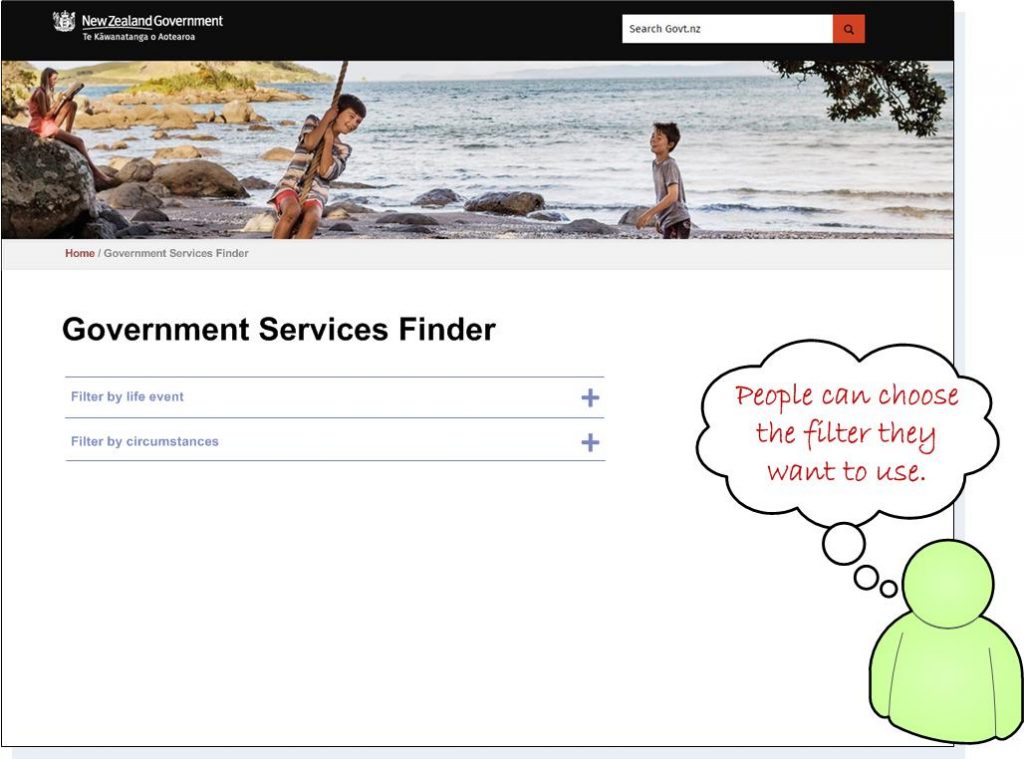
Detailed description of figure 2
This is a mock-up of the Government Services Finder hosted on Govt.nz. This screenshot shows a page from the Govt.nz website with 'Government Services Finder' options for filtering by 'life events' or 'circumstances'. The image has a symbolic person with a thought bubble that says, “People can choose the filter they want to use.”
Figure 3 is a mock-up of the Government Services Finder: Filter by life event page hosted on Govt.nz. The Services Finder allows for users to determine how the information will be filtered by multiple life events. These filters will need to be validated during user testing to make sure we’ve got the right ones.
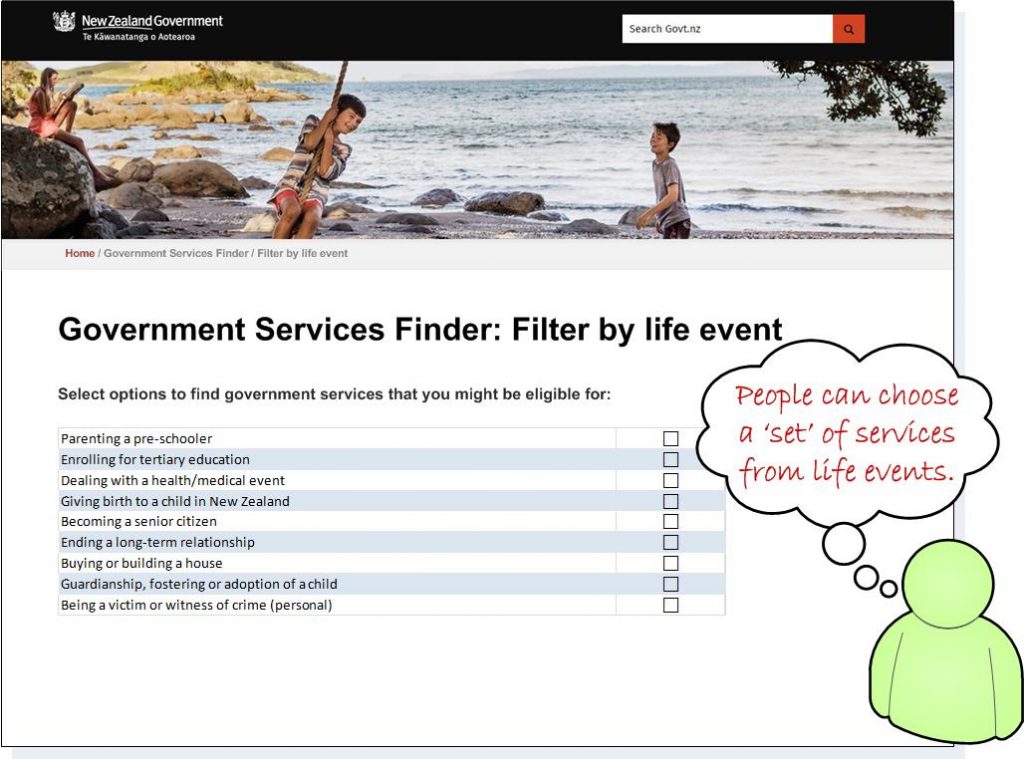
Detailed description of figure 3
This is a mock-up of the Government Services Finder hosted on Govt.nz. This screenshot shows a page from the Govt.nz website with 'Government Services Finder' options for filtering by life events. The image has a symbolic person with a thought bubble that says, “People can choose a ‘set’ of circumstances from life events.” Screenshot showing Govt.nz page with filtering choices as 'life events'.
Figure 4 is a mock-up of the ‘Government Services Finder: Filter by circumstances’ page hosted on Govt.nz. The Services Finder allows people to self-select filters such as age range, gender, residency status, income range etc. These filters will need to be validated during user testing to make sure we’ve got the right ones.
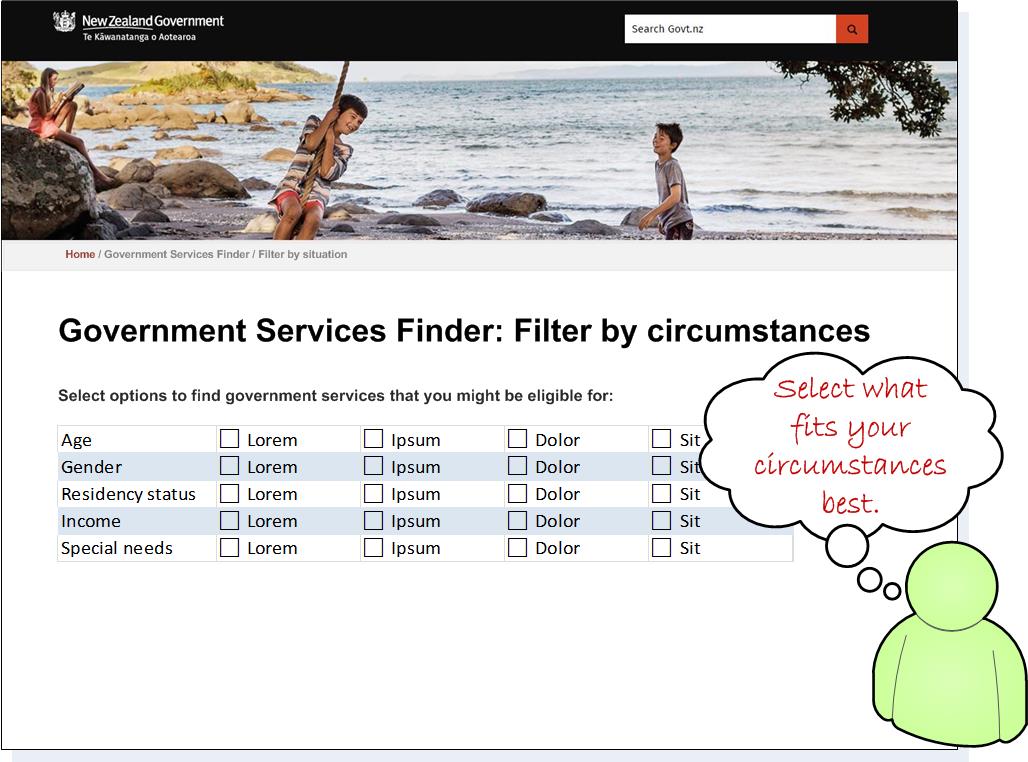
Detailed description of figure 4
This is a mock-up of the ‘Government Services Finder: Filter by circumstances’ page hosted on Govt.nz. This screenshot shows a page from the Govt.nz website with 'Government Services Finder' options for filtering by circumstances such as age range, gender, residency status, income range etc. The image has a symbolic person with a thought bubble that says, “Select what fits your circumstances best.”
Figure 5 is a mock-up of the ‘Government Services Finder: You might be eligible for these services’ page hosted on Govt.nz. This mock-up shows the search results as a list of services people might be eligible for, grouped under life events for reference.
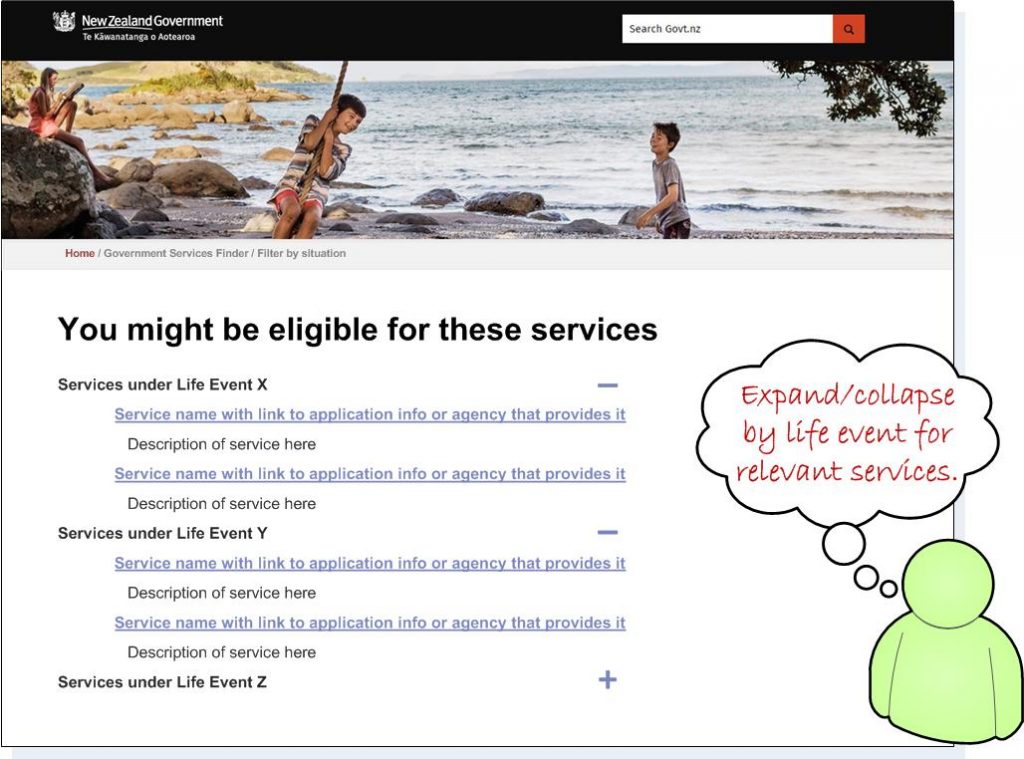
Detailed description of figure 5
This is a mock-up of the ‘Government Services Finder: You might be eligible for these services’ page hosted on Govt.nz. The filtered services are shown grouped under the life event they are related to, listed by service name with a short description of the service.
For example, a service name is “Registering a new baby and getting a birth certificate”. The service description is “Every baby born in New Zealand must be registered, usually within 2 months of being born. It's free, and you can apply for the baby's birth certificate and IRD number at the same time.”
Interested in getting involved?
If the Services Finder/Services Register is something you're interested in, let us know in the comments below or by email and we'll get in touch when we start the next phase of the work.
Lab+ is housed in the Service Innovation Lab, which is an experiment carried out under the leadership of the ICT Partnership Framework’s Service Innovation Group. It's managed by the Service Innovation Team in Department of Internal Affairs in partnership with Assurity Consulting.
Check out earlier blog posts about Lab+ and the Service Innovation Lab.
Follow us on Twitter at @NZLifeEvents.
Published
Categories
Collaboration, Govt.nz, Open data, Public sector, Testing, Web development


